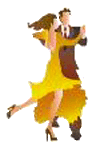 |
ROUND DANCING — CHOREOGRAPHED BALLROOMEDUCATIONAL ARTICLESMAJOR SECTIONS: Figures | Articles | Links | Alph. Index | Search | Home |
|
|
TURNING WALKING INTO DANCING -- RISE & FALLby Harold & Meredith Sears I suppose it is proper that our first concern in dance is—where should we go? Should we go straight, turn left, or right? Our first concern is in the two dimensions of the dance floor. But elegant dancing includes the third dimension, too. Rise and fall is movement in the body, higher and lower, up and down. Elsewhere, we have said that bouncing is bad, but rise and fall is graceful and pretty. We had better be careful to define our terms. A "bounce" is rise and fall that occurs over a single beat of music. You rise as you step off and move from heel to toe, and you fall as you land on the next foot. Bounce is jerky. Can you picture a Slinky toy "walking" down a staircase? The upper end of the coil flips up and over and then plops down onto the next step—up, over, plop… But "rise and fall" occurs over a whole measure of music; it is not jerky but gradual and gentle. Rise and fall gives a whole new layer, that third dimension, of natural flow and movement to our dancing. Where dancing on the diagonal produces graceful wave-like patterns in the two dimensions of the dance floor, rise and fall adds the same kind of richness in the third, vertical dimension.The general rule is that you lower at the beginning of the measure. Lowering accomplishes two things. It allows you to take a long and graceful first step instead of a short clumpy step. Try it. Stand on a straight leg and extend your free foot forward. How far can you reach without shoving your partner or leaning over her? Just a little way. Now lower. Can you reach farther with the free foot? Yes, the more you lower before a step, the longer the step can be. Furthermore, softening the supporting leg (bending the knee) prepares you to push, to propel, the next step. Lowering allows you to reach the free heel farther out, and pushing off the supporting leg allows you to slide that heel forward and so step farther again. If you try to take a long step without lowering first, you will shove; you will come over onto your partner. Again, lowering helps you greatly to progress smoothly, to glide, to travel. Of course, the second thing that lowering does is to set you up for graceful rise and fall. Lower as you begin to do a waltz open telemark, for instance. Soften the trail knee to lower and then drive forward onto the lead foot. She feels the lowering and is ready to go before you really start to progress. At the end of beat one, begin to rise. Continue to rise through beat two and into beat three. Lower again at the end of the measure. Over the whole measure, this movement is graceful and gentle, not bouncy. Being up is not just an extended knee (never locked). It is being on the balls of your feet, and it is being erect and stretched in your torso—lungs full perhaps and back a bit arched, head up. But don't lift or shrug your shoulders in an effort to be "up." Rise and fall must not disturb your toned frame. You can distinguish between "foot rise" and rise in the rest of the body. Often, you will rise only through the leg and torso. Sometimes, you will add that little extra with foot-rise. Rise and fall is used differently in the different smooth rhythms. It is most conspicuous in waltz, where we spend about the same amount of time dancing "down" as in dancing "up." In foxtrot and even in quickstep, we get up more quickly and we stay up longer. There is rise and fall in foxtrot, but the overall look of the dance is flatter, more up and floating. Waltz has been compared to mountains and valleys and foxtrot to rolling hills. Tango is flat; there is no rise and fall.
A version of this article appeared as “Icing On the Cake” in the Dixie Round Dance Council (DRDC) Newsletter, March, 2005.
If you would like to read other articles on dance position, technique, styling, and specific dance rhythms, you may visit the article TOC. Past DRDC Educational Articles archived here. Go beyond this site. Find other references on our Sources and Links pages.
|
 |
|
|
Page last revised